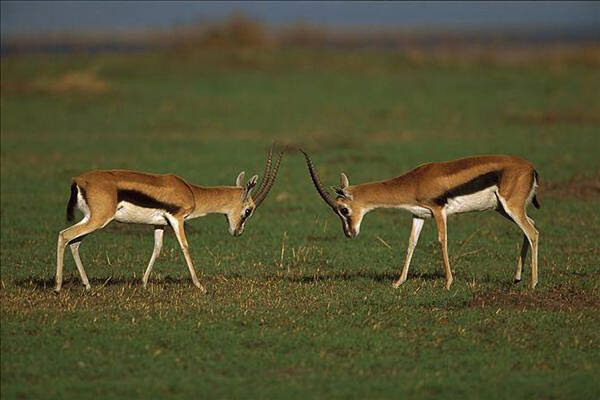Eudorcas thomsonii
IUCN
LCBasic Information
Scientific classification
- name:Eudorcas thomsonii
- Scientific Name:Eudorcas thomsonii,Thomson's gazelle, Thompson's gazelle, Thomson's gazelle
- Outline:Ungulata
- Family:Artiodactyla Bovidae Gazelle
Vital signs
- length:80-120cm
- Weight:15-35kg
- lifetime:10-15years
Feature
Thomson's gazelle is one of the most famous antelopes. It can turn left and right while running.
Distribution and Habitat
Distributed in Tanzania, Kenya, Sudan, and Uganda.
Inhabits savannas and open grasslands in Africa, especially in the Serengeti National Park in Kenya and Tanzania. Can survive in relatively dry seasons, but will still be active in grasslands that are overgrazed or burned and other large herbivores have moved to humid habitats.
Appearance
The Thomson's gazelle is a small gazelle, short and stocky, with males weighing 20-35 kg and females 15-25 kg; the body length is about 80-120 cm. The abdomen and legs are white, and the back and the rest are yellow-brown to reddish-brown. There are black stripes on the ventral side that divide the back and abdomen horizontally. The buttocks are white and the tail is black. There is reddish-brown fur on the cheeks, and a black stripe extending from the eyes to the nose is bordered, forming a wide white stripe with the bridge of the nose to the top of the forehead. Both males and females have horns, the male's horns are curved at the tip and have threads; the female's horns are smaller. The Thomson's gazelle is a bit like the Grant's gazelle (Nanger granti), Grant's gazelle is larger, with horns that curve outward, and the white area on their buttocks extends to the top of the tail.
Strong physique; legs suitable for long-distance running; 4 toes on feet
Details
Thomson's gazelle, scientific name: Eudorcas thomsonii (Günther, 1884) foreign name Thomson's gazelle, has 2 subspecies.

Thomson's gazelles are good at running and are very alert. They run away at the first sign of movement. They are gregarious and often form the world's most spectacular herbivore groups with wildebeests. However, since gazelles and wildebeests have different migration purposes, their migration routes will also be different. Thomson's gazelles gather in small groups, but their organizational structure is very flexible, and there are often mixed groups and overlapping groups in each group. Migrate together to find pastures and grasslands. Males compete for control of the territory, using the secretions of the scent glands under their eyes and feces to mark the territory between the grass and branches, demarcate their favorite pastures and win the favor of females. When a border conflict occurs between two areas, the victory or failure is usually determined by violent fighting. Especially during the mating season, gazelle corpses with two holes are often seen, which are killed by their own kind. The natural enemies are the same as springboks, and on land they are cheetahs and leopards.
Thomson's gazelle is a typical herbivore. The diet includes herbs and shrubs, and it likes to eat leaves and pods on trees. It also digs up the underground organs of bulbs, corms and other fleshy plants to improve the water balance in the body. It needs to drink water every two days. If it is in the dry season of the grassland, it sometimes needs to walk 16 kilometers a day to drink water. It eats fresh grass in the rainy season and seeds and leaves of shrubs in the dry season.

Thomson's gazelles can breed all year round, with the peak period after the rainy season. The gestation period is about 188 days, with one calf born per litter, weighing 3 kg, and can stand and walk soon after birth. Female gazelles will leave the herd for up to two months a few days before giving birth. Lambs can stand and walk soon after birth. But they will curl up with their eyes closed in the hidden position with their mothers for the first week. The mother forages nearby and watches over her children, fighting off small predators such as foxes, or trying to lead larger predators such as jackals and wolves out of hiding. After 3-6 weeks, the young begin to gradually accompany their mothers and walk around and begin to be fed solid food. The lactation period can last for 3-4 months. Young females will stay in their mother's group, and males will leave their original group at around six months and join a group of young single males. Females reach sexual maturity after a year, but more often than not, two years; males need 15 to 20 months, but in reality, adult males rarely participate in reproduction at this time until they occupy their own territory after three years of age.
Although Thomson's gazelles do not face any major threats, there is evidence that the number of some groups is declining. In the Ngorongoro Volcanic Area, the decline in the number of these groups is due to reduced precipitation, tourism impacts, invasion of alien plants, and road development, which have changed the living environment and fragmented the habitat. There are many Thomson's gazelles living in the protected area, but because the distribution is too narrow, the overall number is still not large.
Listed in the 2018 Red List of Endangered Species of the World Conservation Union - Least Concern (LC).
Protect wild animals and eliminate game.
Maintaining ecological balance is everyone's responsibility!








